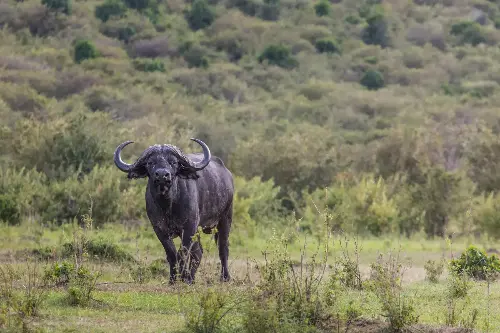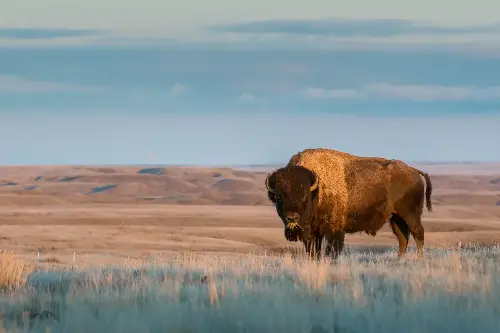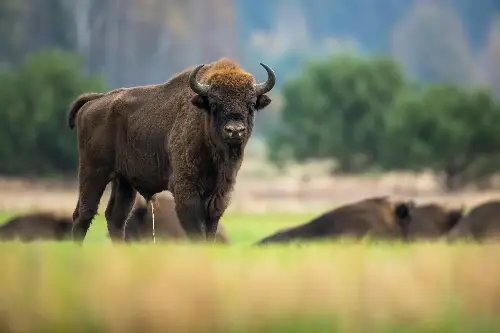These hoofed behemoths that roam the plains and forests of the world often stir up confusion with their similar appearances and overlapping common names. Bison and buffalo, though related, are distinct animals with unique traits and habitats that not only differentiate them but also underscore the incredible diversity within the Bovidae family. In this article, we aim to untangle the commonly misunderstood distinctions and demonstrate how these magnificent creatures fit into our planet's intricate tapestry of wildlife.

Picture of an African Buffalo.
Understanding the Difference
A key differentiation between bison and buffalo starts with their geographic habitats. The term 'buffalo' is rightly assigned to two main species: the African buffalo, also known as the Cape buffalo (Syncerus caffer), and the Asian water buffalo (Bubalus bubalis). In contrast, the term 'bison' refers to the species that roam North America and Europe—the American bison (Bison bison) and the European bison, or wisent (Bison bonasus), respectively.
Morphological Marvels
The physical differences between these animals are quite striking once you know what to look for. Bison sport a heavier, more rugged coat, particularly the American bison, which needs to withstand the harsh winters of the Great Plains. Their heads are massive, crowned with a thick growth of fur, and both sexes boast short, curved horns. One of the most iconic features of the American bison is the large shoulder hump, which supports their powerful front muscles used for foraging through snow.
Buffalo, on the other hand, have slicker coats and longer, more pronounced horns that can span up to an impressive two meters in some species. Unlike bison, buffaloes lack the distinctive shoulder hump and have a more uniform profile.

Ecosystem Engineers
Their role in the ecosystem is monumental. Bison are known as 'keystone species' for their ability to shape the environment. They trample grass, aiding in seed dispersal and promoting plant diversity. Their wallowing behaviour—rolling in dirt to rid themselves of parasites—creates depressions that collect water, benefiting a host of other species.
Similarly, water buffaloes, with their preference for wallowing in wetlands, maintain open areas in marshes and rivers, which encourages biodiversity and provides habitats for aquatic plants and animals.
Historical Significance and Conservation
Culturally, both bison and buffalo hold great importance. For many Indigenous North American tribes, the bison was a cornerstone of life, providing food, materials for clothing and shelter, and spiritual significance. Likewise, in parts of Asia, water buffaloes have been domesticated for thousands of years, contributing significantly to agriculture and transport.
However, the survival of these species has been challenged by human activity. The American bison narrowly escaped extinction in the 19th century due to overhunting and habitat destruction. Conservation efforts have since restored some populations, but the species remains dependent on these continued efforts. In Europe, the wisent faced a similar fate, with restoration programs only beginning after the species had been completely wiped out in the wild post World War I.
Buffalo populations have also suffered from hunting and habitat loss, although the impacts vary between the African and Asian species. While African buffaloes are still fairly widespread on the continent, the wild Asian water buffalo is now classified as endangered.

Encounters in the Wild
For the adventurous spirit seeking to witness these animals in their natural habitats, various national parks and reserves offer the opportunity to do so responsibly. In the United States, places like Yellowstone National Park provide a refuge for the American bison. European bison have been reintroduced to several areas in Eastern Europe, including Poland's Białowieża Forest. Meanwhile, to encounter African buffaloes, one could venture to savanna reserves such as the Serengeti or Kruger National Park, and for Asian water buffaloes, protected areas in Nepal and India are your best bet.
It is crucial to maintain a respectful distance when observing these animals; despite their often-placid appearance, they are wild creatures with unpredictable demeanours and formidable strength.
A Legacy of Resilience
Bison and buffalo are not just survivors of the past; they are contemporary symbols of nature's resilience and the ongoing efforts of conservation. Their existence reminds us of the delicate balance within ecosystems and the need for informed actions to preserve our natural world. These majestic creatures carry a legacy that is worth understanding and protecting, through a blend of respect, fascination, and advocacy.
In deciphering the distinctions between bison and buffalo, we not only gain insight into their unique lives but also develop a deeper appreciation for the diversity of wildlife sharing our planet. Championing their survival is not just an act of conserving species; it is an investment in maintaining the integrity of ecosystems and cultural heritages that span generations. Through education and engagement, we can ensure that the thundering hooves of bison and buffalo continue to resound for centuries to come.
